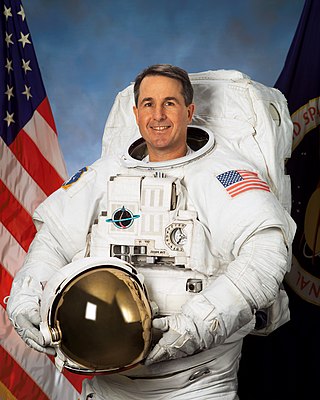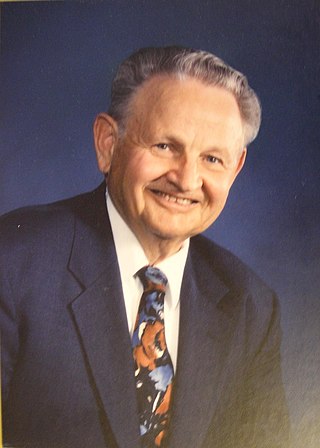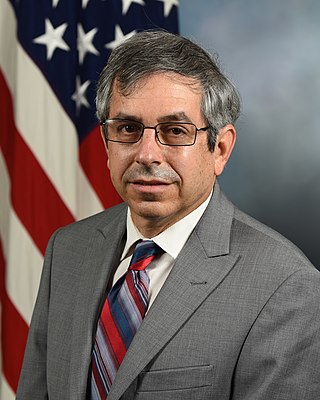
Sandra Hall Magnus is an American engineer and a former NASA astronaut. She returned to Earth with the crew of STS-119 Discovery on March 28, 2009, after having spent 134 days in orbit. She was assigned to the crew of STS-135, the final mission of the Space Shuttle. She is also a licensed amateur radio operator with the call sign KE5FYE. From 2012 until 2018 Magnus was the executive director of the American Institute of Aeronautics and Astronautics.

Stephen Kern "Steve" Robinson is an American former NASA astronaut.

The American Institute of Aeronautics and Astronautics (AIAA) is a professional society for the field of aerospace engineering. The AIAA is the U.S. representative on the International Astronautical Federation and the International Council of the Aeronautical Sciences. In 2015, it had more than 30,000 members among aerospace professionals worldwide.
Paul D. Spudis (1952–2018) was an American geologist and lunar scientist. His specialty was the study of volcanism and impact processes on the planets, including Mercury and Mars.

Harry Julian Allen, also known as Harvey Allen, was an aeronautical engineer and a Director of the NASA Ames Research Center, most noted for his "Blunt Body" theory of atmospheric entry which permitted successful recovery of orbiting spacecraft. His technique is still used to this day.

Stanley F. Schmidt was an American aerospace engineer who pioneered the Schmidt-Kalman filter used in air and space navigation, most notably in Apollo spacecraft.
Jerome Pearson was an American engineer and space scientist best known for his work on space elevators, including a lunar space elevator. He was president of STAR, Inc., and has developed aircraft and spacecraft technology for the United States Air Force, DARPA, and NASA. He held several patents and was the author of nearly 100 publications in aircraft, spacecraft, electrodynamic tethers, SETI, and global climate control.
Dr. Henry "Harry" McDonald DSc FREng was a Scottish-American aeronautical engineer specializing in Computational Fluid Dynamics and Director of the NASA Ames Research Center in Moffett Field, California from 1996 to 2002.
Jeongbin John Kim is the Rockwell International Distinguished Professor of mechanical and aerospace engineering in the UCLA Henry Samueli School of Engineering and Applied Science, since 1993. He currently resides in Calabasas, California.

Louis John Lanzerotti is an American physicist. He is a Distinguished Research Professor of physics in the Center for Solar-Terrestrial Research at New Jersey Institute of Technology (NJIT) in Newark, New Jersey.

David Morrison is an American astronomer, a senior scientist at the Solar System Exploration Research Virtual Institute, at NASA Ames Research Center in Mountain View, California. Morrison is the former director of the Carl Sagan Center for Study of Life in the Universe at the SETI Institute and of the NASA Lunar Science Institute. He is the past Director of Space at NASA Ames. Morrison is credited as a founder of the multi-disciplinary field of astrobiology. Morrison is best known for his work in risk assessment of near Earth objects such as asteroids and comets. Asteroid 2410 Morrison was named in his honor. Morrison is also known for his "Ask an Astrobiologist" series on NASA's website where he provides answers to questions submitted by the public. He has published 12 books and over 150 papers primarily on planetary science, astrobiology and near Earth objects.

Ulfila Mark J. Lewis is a senior American aerospace and defense executive with special expertise in hypersonics. He is currently the Executive Director of the National Defense Industrial Association's Emerging Technologies Institute, following his role in the second half of 2020 as the acting US Deputy Under Secretary of Defense for Research and Engineering, and before that the Director of Defense Research and Engineering for Modernization. He was the Chief Scientist of the U.S. Air Force, Washington, D.C. from 2004 to 2008 and was the longest-serving Chief Scientist in Air Force history. He served as chief scientific adviser to the Chief of Staff and Secretary of the Air Force, and provided assessments on a wide range of scientific and technical issues affecting the Air Force mission. In this role he identified and analyzed technical issues and brought them to attention of Air Force leaders, and interacted with other Air Staff principals, operational commanders, combatant commands, acquisition, and science & technology communities to address cross-organizational technical issues and solutions. His primary areas of focus included energy, sustainment, long-range strike technologies, advanced propulsion systems, and workforce development.

G. Scott Hubbard is a physicist who has been engaged in space-related research as well as program, project and executive management for more than 45 years including 20 years with NASA, culminating as director of NASA's Ames Research Center. As of 2012, Hubbard chairs SpaceX Safety Advisory Panel, he previously served as the NASA representative on the Columbia Accident Investigation Board, was NASA's first Mars program director and restructured the Mars program in the wake of mission failures.

William J. (Bill) Borucki is a space scientist who worked at the NASA Ames Research Center. Upon joining NASA in 1962, Borucki joined the group conducting research on the heat shield for Apollo program spacecraft. He later turned his attention to the optical efficiency of lightning strikes in the atmospheres of planets, investigating the propensity that these lightning strikes could create molecules that would later become the precursors for life. Subsequently, Borucki's attention turned to extrasolar planets and their detection, particularly through the transit method. In light of this work, Borucki was named the principal investigator for NASA's Kepler mission, launched on March 7, 2009 and dedicated to a transit-based search for habitable planets. In 2013, Borucki was awarded the United States National Academy of Sciences's Henry Draper Medal for his work with Kepler. In 2015 he received the Shaw Prize in Astronomy.

Leroy Stevenson (Skipp) Fletcher is an American mechanical and aerospace engineer, and college dean, who served as the 104th president of the American Society of Mechanical Engineers in 1985–86, and was recipient of the 2002 ASME Medal.

Charles Meneveau is a French-Chilean born American fluid dynamicist, known for his work on turbulence, including turbulence modeling and computational fluid dynamics.
Yvonne Jean Pendleton is an American astrophysicist and is currently the Chief Scientist of NASA’s Solar System Exploration Research Virtual Institute (SSERVI) at Ames Research Center in Mountain View, California. Pendleton earned degrees from the Georgia Institute of Technology, Stanford University, and the University of California at Santa Cruz and was hired by NASA as a civil servant in 1979. She served as a research scientist in the Space Science and Astrobiology Division at NASA Ames Research Center (ARC) until 2007, including as Division Chief from 2006-7. In 2007 she was promoted to the Senior Executive Service, the highest level of civil service within the Federal government, and throughout her career has served in high-level leadership positions at both NASA's ARC and Headquarters. Her scientific research has investigated the origin and evolution of organic material in our galaxy and is currently focused on the composition of the solar nebula from which our Solar System formed. She is an elected fellow of the California Academy of Sciences and Asteroid 7165. Pendleton was named by the International Astronomical Union in honor of her research contributions.
Azadeh Tabazadeh is an Iranian geophysicist and author known for her work in atmospheric science, work which has improved our understanding of the reactions that affect ozone depletion and highlighted the impact human activity has on the atmosphere.

Subrata Roy is an Indian-born American inventor, educator, and scientist known for his work in plasma-based flow control and plasma-based self-sterilizing technology. He is a professor of Mechanical and Aerospace Engineering at the University of Florida and the founding director of the Applied Physics Research Group at the University of Florida.
Walter Guido Vincenti was an American engineer who worked in the field of aeronautics, designing planes that could fly at hypersonic speed. He was elected as a member of several scientific societies, including the American Institute of Aeronautics and Astronautics and National Academy of Engineering. He won several prestigious awards, such as the Leonardo da Vinci Medal and the Daniel Guggenheim Medal.












